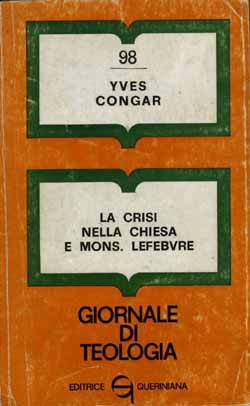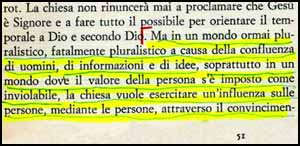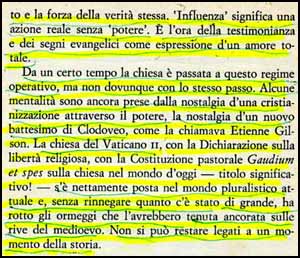Known theologian Card. Yves Congar, co-author of 10 of the 16 final documents of Vatican II, judges that with Dignitatis humanae and Gaudium et spes, the Council abandoned the doctrines that linked the Catholic Church to the past, which he generically calls the Middle Ages. The two Vatican II documents deal respectively with religious liberty and the Church in the modern world.
Right, the cover of The Crisis in the Church and Msgr. Levèbvre, the Italian text follows at right below, and at left below is our translation of the Italian excerpts highlighted in yellow.
In a world that is finally pluralist - that irreversibly became pluralist due to a convergence of men, information and ideas in a world where the value of the person has imposed itself as inviolable – the Church wants to exercise an influence on people through people by means of persuasion and the strength of truth itself. ‘Influence’ means a real action without ‘power.’ It is the hour of testimonies and evangelical signs as an expression of a total love.
For some time now, the Church has been changing her operative mode, but not in the same way everywhere. Some mentalities are still dominated by nostalgia for a Christianization through power, nostalgia for a new baptism of Clovis, as Etienne Gilson called it. The Church of Vatican II, with her declaration on religious liberty [Dignitatis humanae] and the pastoral constitution Gaudium et spes on the Church in the modern world – a meaningful title! – clearly placed herself in the modern pluralist world and, without denying what she has of the grand, broke the ties that anchored her to the shores of the Middle Ages. One cannot remain bound to one moment of History.
(Yves Congar, La crisi nella Chiesa e Mons. Levèbvre (Brescia: Queriniana, 1976) pp. 51-52)
|



|
|
